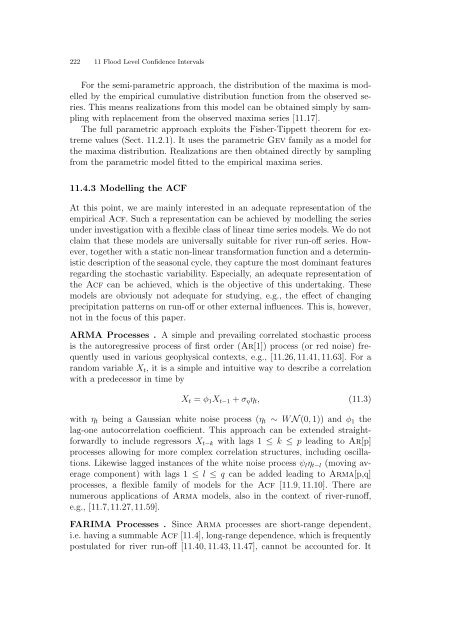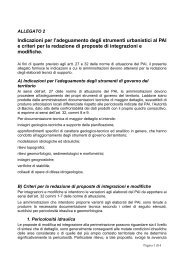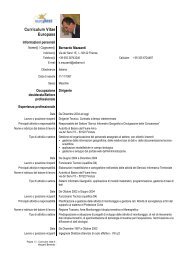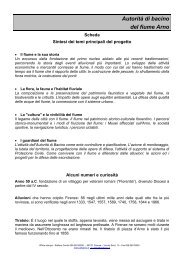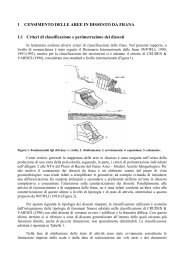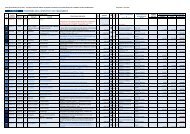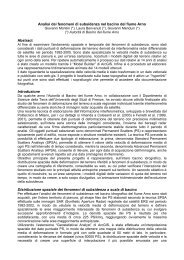11. Confidence Intervals for Flood Return Level Estimates assuming ...
11. Confidence Intervals for Flood Return Level Estimates assuming ...
11. Confidence Intervals for Flood Return Level Estimates assuming ...
Create successful ePaper yourself
Turn your PDF publications into a flip-book with our unique Google optimized e-Paper software.
222 11 <strong>Flood</strong> <strong>Level</strong> <strong>Confidence</strong> <strong>Intervals</strong>For the semi-parametric approach, the distribution of the maxima is modelledby the empirical cumulative distribution function from the observed series.This means realizations from this model can be obtained simply by samplingwith replacement from the observed maxima series [<strong>11.</strong>17].The full parametric approach exploits the Fisher-Tippett theorem <strong>for</strong> extremevalues (Sect. <strong>11.</strong>2.1). It uses the parametric Gev family as a model <strong>for</strong>the maxima distribution. Realizations are then obtained directly by samplingfrom the parametric model fitted to the empirical maxima series.<strong>11.</strong>4.3 Modelling the ACFAt this point, we are mainly interested in an adequate representation of theempirical Acf. Such a representation can be achieved by modelling the seriesunder investigation with a flexible class of linear time series models. We do notclaim that these models are universally suitable <strong>for</strong> river run-off series. However,together with a static non-linear trans<strong>for</strong>mation function and a deterministicdescription of the seasonal cycle, they capture the most dominant featuresregarding the stochastic variability. Especially, an adequate representation ofthe Acf can be achieved, which is the objective of this undertaking. Thesemodels are obviously not adequate <strong>for</strong> studying, e.g., the effect of changingprecipitation patterns on run-off or other external influences. This is, however,not in the focus of this paper.ARMA Processes . A simple and prevailing correlated stochastic processis the autoregressive process of first order (Ar[1]) process (or red noise) frequentlyused in various geophysical contexts, e.g., [<strong>11.</strong>26,<strong>11.</strong>41,<strong>11.</strong>63]. For arandom variable X t , it is a simple and intuitive way to describe a correlationwith a predecessor in time byX t = φ 1 X t−1 + σ η η t , (<strong>11.</strong>3)with η t being a Gaussian white noise process (η t ∼ W N(0, 1)) and φ 1 thelag-one autocorrelation coefficient. This approach can be extended straight<strong>for</strong>wardlyto include regressors X t−k with lags 1 ≤ k ≤ p leading to Ar[p]processes allowing <strong>for</strong> more complex correlation structures, including oscillations.Likewise lagged instances of the white noise process ψ l η t−l (moving averagecomponent) with lags 1 ≤ l ≤ q can be added leading to Arma[p,q]processes, a flexible family of models <strong>for</strong> the Acf [<strong>11.</strong>9, <strong>11.</strong>10]. There arenumerous applications of Arma models, also in the context of river-runoff,e.g., [<strong>11.</strong>7,<strong>11.</strong>27,<strong>11.</strong>59].FARIMA Processes . Since Arma processes are short-range dependent,i.e. having a summable Acf [<strong>11.</strong>4], long-range dependence, which is frequentlypostulated <strong>for</strong> river run-off [<strong>11.</strong>40, <strong>11.</strong>43, <strong>11.</strong>47], cannot be accounted <strong>for</strong>. It


